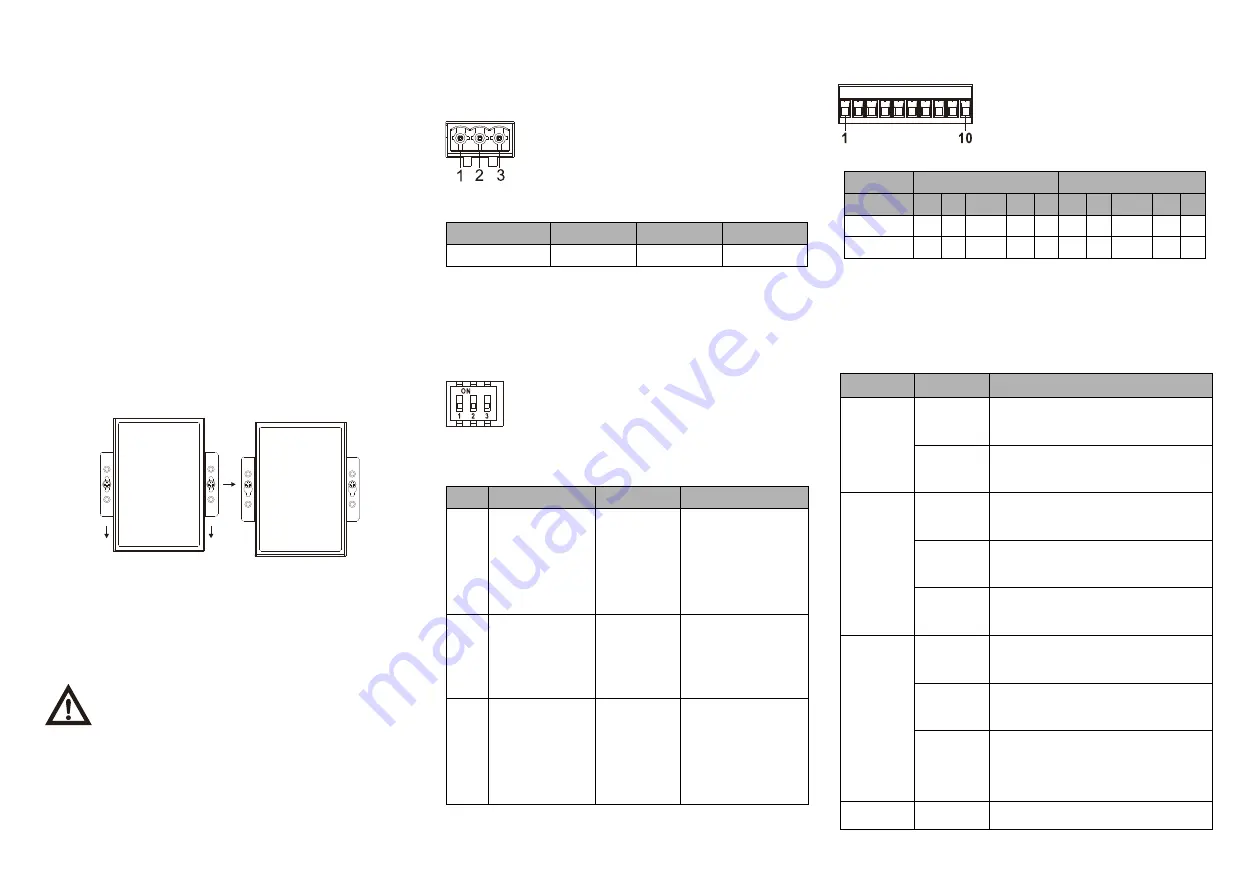
surrounding between 5%~95% without condensation.
Before power on, first confirm the supported power
supply specification to avoid over-voltage damaging the
device.
The device surface temperature is high after running;
please don't directly contact to avoid scalding.
【
Wall-mounted Device Mounting
】
Step 1
On the wall of device mounting, place the device on
the wall for reference or refer to the mounting
dimension to mark two screw positions.
Step 2
Nail M4 screws on the wall and keep 2mm
interspace reserved.
Step 3
Hang the device on two screws and slide downward,
then tighten the screw to enhance stability,
mounting ends.
【
Wall-mounted Device Disassembling
】
Step 1
Power off the device.
Step 2
Unscrew the screw on the wall about 2mm.
Step 3
Lift the device upward slightly; take out the device,
disassembling ends.
Notice before power on:
Power ON operation: First insert the power supply
terminal block into the device power supply interface,
and then plug the power supply plug contact and power
on.
Power OFF operation: first unpin the power plug, then
remove the power line, please note the operation order
above.
【
Power Supply Connection
】
This device provides 1 DC power supply which
is 3-pin 5.08mm pitch terminal blocks, the power
supply supports non-polarity. Voltage range:
12~48VDC. The pin definitions of the terminals
are shown as follows:
PIN
1
2
3
Definition
V+
FG
V-
【
Reset Button Setting
】
This device provides 1 reset button, press the button for 4-5S
then release it to restore factory defaults.
【
DIP Switch Setting
】
The device provides 3 DIP switches for 2 serial
ports respectively, and the switches are located
on the back of the device, which can be seen by
opening the cover plate. In which "ON" is the enable end. The
DIP switches are defined as follows.
No. Definition
Operation Description
1
Set the D- pull-
down
resistance to
1K.
Set the
switch to
ON
If the switch is not
set to ON, the
pull-down
resistance is
150K.
2
Set the D+
pull-up
resistance to
1K.
Set the
switch to
ON
If the switch is not
set to ON, the
pull-up resistance
is 150K.
3
Set the
terminal
resistance to
increase by
120
Ω
Set the
switch to
ON
—
【
Console Port Connection
】
This device provides 2 RS-485/422
serial ports, support RS-485 or RS-
422, and interface adopts 10-pin
terminal blocks. The pin definitions
are shown in the following table:
COM
COM1
COM2
PIN
1 2 3
4 5 6 7 8
9 10
RS-485
D+ D- GND
—
—
D+ D- GND
—
—
RS-422
T+ T- GND R+ R- T+ T- GND R+ R-
【
Checking LED Indicator
】
The device provides LED indicators to monitor its operating
status, which has simplified the overall troubleshooting
process. The function of each LED is described in the table
below:
LED
Indicate
Description
PWR
ON
PWR is connected and running
normally
OFF
PWR is disconnected or running
abnormally
RUN
ON
The device is powering on or the
device is abnormal.
OFF
The device is powered off or the
device is abnormal.
Blinking
Blinking 1 time per second, the
device is running normally.
LINK
ON
The copper port has established
an active network connection.
Blinking
The copper port is in an active
network status
OFF
The copper port has not
established an active network
connection.
TX1-TX2 OFF
The serial port is not transmitting





















